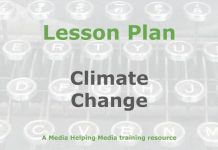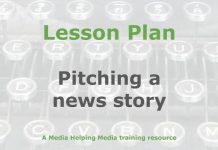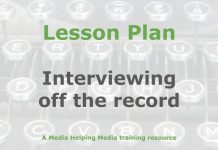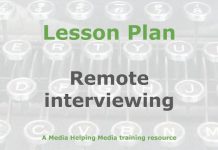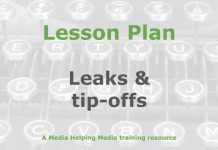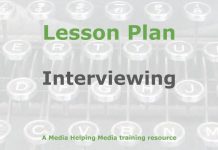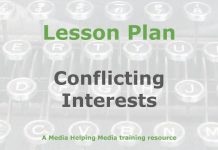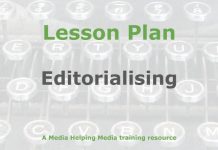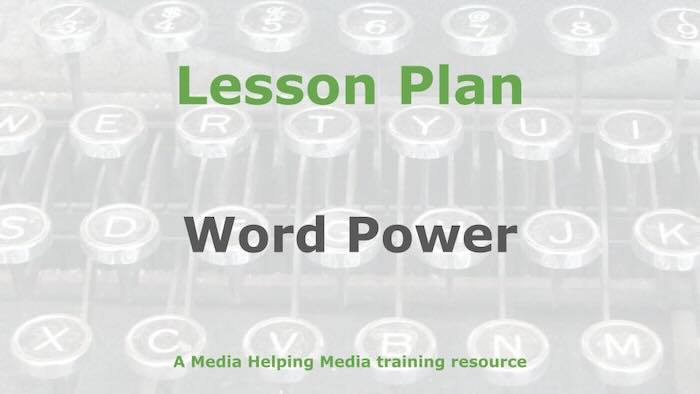 This lesson plan is designed to teach students the power of words and how to use them when writing a piece of journalism.
This lesson plan is designed to teach students the power of words and how to use them when writing a piece of journalism.
It’s based on the article ‘Using the right words‘ which we recommend trainers read before adapting the outline below for your own purposes.
Learning objective
Students will analyse and apply the correct use of words in journalism by identifying and correcting common word usage errors. They will evaluate the impact of word choice on clarity and accuracy in journalistic writing.
- Student-facing objective: By the end of this lesson the student will be able to spot and fix common word mistakes in journalism and understand how word choice affects the clarity and truthfulness of news stories.
- Standards: Students will understand the power of words and what to use and what not to use.
Learning activities
Warm-up
Begin with a brief discussion about the importance of word choice in journalism. Ask students to think of a recent news story they read or heard. Prompt them to consider how the choice of words might have influenced their understanding or perception of the story.
Next, present a short sentence with a deliberately incorrect word choice, such as “The politician was assassinated in a car accident.” Ask students to identify the error and suggest a correction. Discuss how the incorrect word changes the meaning and impact of the sentence.
Conclude by emphasising the role of precise language in conveying accurate information. This activity primes students for the lesson’s focus on identifying and correcting word usage errors.
Direct instruction
Conceptual understanding: Introduce key word classifications in journalism. Explain the roles of nouns, verbs, adjectives, adverbs, pronouns, and prepositions in sentence construction. Use real examples from recent news articles to illustrate how each word type contributes to clarity and meaning. Discuss the impact of incorrect word choice on the reader’s understanding.
Procedural skills and fluency: Present common word usage errors in journalism, such as “affect/effect” and “fewer/less“. Provide sentences with these errors then ask students to identify and correct them. Use examples such as: “The new policy will effect many changes” and “There are less people attending the event”. Guide students through the correction process, emphasising the importance of precision in word choice.
Application: Assign a brief writing task where students draft a short news report on a given topic. Instruct them to focus on using precise language and avoiding common word usage errors. After writing, have students exchange reports with a partner to peer-review for word choice accuracy. Encourage them to provide constructive feedback and suggest improvements.
Guided practice
Think, Pair, Share: Begin by presenting a sentence with a word usage error, such as “The team was decimated by injuries”. Ask students to individually identify the error and think of a correction.
- Pair: Pair students to discuss their thoughts and agree on a corrected version of the sentence. Encourage them to explain their reasoning to each other.
- Share: Invite pairs to share their corrections with the class. Discuss the impact of the incorrect word on the sentence’s meaning and clarity.
- Collect and display: As students share, write their corrections and explanations on the board. Organise these into categories of common errors and correct usage.
Conclude with a class discussion on the importance of precise word choice in journalism, reinforcing the lesson’s learning objective.
Independent practice
- Assign students a set of sentences containing common word usage errors. Direct them to identify and correct each error, focusing on clarity and accuracy.
- Provide a list of frequently confused words and ask students to create sentences using each word correctly.
- Encourage students to rewrite a short news article, replacing vague or incorrect words with precise alternatives.
- Circulate to observe and support students as they work.
Assignment
Ask students:
- What is one example of a word usage error you corrected today?
- How does precise word choice affect the clarity of a news story?
- What’s one question you still have from today’s lesson?
Some suggested answers:
- Suggested answer to Question 1: “I corrected ‘effect’ to ‘affect’ in a sentence about policy changes.”
- Suggested answer to Question 2: “Precise word choice ensures the reader understands the intended message without confusion.”
Teacher resources
Differentiation guide
Advanced learners: Encourage deeper analysis by having students explore the etymology of commonly confused words. Challenge them to create a mini-presentation on how word origins influence current usage. Offer opportunities to write more complex news articles, focusing on nuanced word choice and style.
Striving learners: Simplify tasks by providing sentence starters or word banks for writing exercises. Use visual aids, such as charts or diagrams, to illustrate word classifications and common errors. Pair them with peers for collaborative learning and provide additional examples for practice.
Recommended reading: Trainers using this lesson outline should consider reading the article ‘Using the right words‘ which we recommend you read before adapting the material for your own purposes.
Notable definitions
- Noun: A word that names a person, place, thing, or idea (e.g., journalist, city, article).
- Verb: A word that expresses an action or a state of being (e.g., write, report, is).
- Adjective: A word that describes or modifies a noun (e.g., accurate, detailed, recent).
Required materials
- Whiteboard and markers
- Printed handouts with sentences containing word usage errors
- List of frequently confused words
- Copies of a short news article for rewriting exercise
- Peer review checklist for word choice accuracy
- Access to computers for digital writing and editing
- Access to the article ‘Using the right words‘ on which this lesson plan is based.
Lesson summary
- Warm-up
- Direct instruction
- Guided practice
- Independent practice
- Assignment
The free teaching tools at the Khan Academy were used in the production of this lesson plan.
Related article
